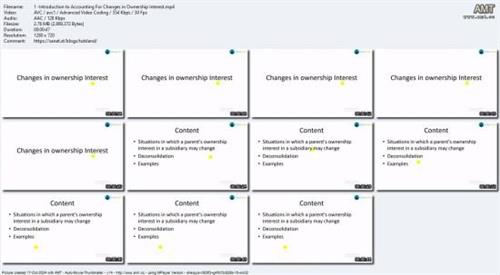Accounting for Changes in Ownership Interest
Published 10/2024
MP4 | Video: h264, 1280x720 | Audio: AAC, 44.1 KHz, 2 Ch
Language: English | Duration: 1h 4m | Size: 303 MB
Master the art of accounting for ownership changes and elevate your financial expertise to a new level!
What you'll learn
The fundamentals of accounting for changes in ownership interest.
How to handle transactions involving parent and subsidiary companies.
The financial implications of issuing and buying back equity shares.
Understanding changes in non-controlling interest (NCI).
Deconsolidation processes and their accounting treatment.
Key differences in handling ownership changes under GAAP and IFRS.
Practical application through real-world examples and case studies.
Impact of discontinued operations on financial statements.
Requirements
Basic understanding of financial accounting principles.
Familiarity with concepts like equity, liabilities, and ownership.
Knowledge of consolidated financial statements (recommended).
A general understanding of GAAP and IFRS accounting standards.
Interest in corporate finance, especially mergers, acquisitions, and restructuring.
Description
In today's evolving corporate landscape, understanding how changes in ownership interest impact financial statements is crucial for professionals working in accounting and finance. This course provides a structured approach to mastering the accounting treatments for various ownership changes, from initial transactions involving non-controlling interests to complex deconsolidation and discontinued operations. You'll gain the skills necessary to handle real-world scenarios, ensuring compliance with key accounting standards like GAAP and IFRS.Section 1: IntroductionThis section serves as an introduction to the fundamental concepts of accounting for changes in ownership interest. It provides an overview of the key principles that govern these changes, including how they impact financial reporting. Students will learn about the importance of accurately reflecting changes in ownership in a company's financial statements and how these changes can affect the control, equity, and liabilities of a company. This foundation is essential for understanding the more complex topics covered in later sections.Section 2: Accounting for Changes in Ownership InterestThis section focuses on the detailed accounting treatments required when ownership interest in a company changes. It explores different scenarios such as equity transactions between parent companies and non-controlling shareholders and how these transactions are recorded. The section delves into the technical accounting methods that companies use to track ownership changes and their impact on consolidated financial statements. By the end of this section, students will be well-versed in how to record and report various types of ownership adjustments.Section 3: Situations in Which a Parent's Ownership Interest ChangesIn this section, students will explore a variety of real-world situations where a parent company's ownership in its subsidiary changes. Topics include issuing additional equity shares, equity buybacks, and changes involving non-controlling interests. The section examines the accounting implications of each situation and how it affects the parent and subsidiary's financial standings. This section is essential for understanding how corporate transactions alter the dynamics between parent companies and their subsidiaries and the reporting challenges these changes can present.Section 4: DeconsolidationThis section introduces the concept of deconsolidation, which occurs when a parent company loses control over a subsidiary. It covers the process of recognizing and recording a deconsolidation event, the financial statement implications, and the reclassification of previously consolidated assets and liabilities. Students will learn the step-by-step accounting process for deconsolidation and its impact on the overall financial health of the parent company. This section is critical for understanding how to handle more advanced changes in corporate structure.Section 5: Examples of Ownership ChangesIn this final section, students will apply their knowledge through real-life examples of ownership changes. The section focuses on case studies involving discontinued operations and various ownership changes. By working through practical examples, students will gain a deeper understanding of how ownership changes are handled in different corporate scenarios. This hands-on approach reinforces the key concepts covered throughout the course and prepares students to deal with complex ownership issues in their professional careers.ConclusionBy completing this course, students will have developed a comprehensive understanding of how to account for changes in ownership interest, including the more complex areas of deconsolidation and discontinued operations. This course will empower financial professionals to confidently navigate the challenges posed by changes in corporate ownership, ensuring accurate financial reporting and compliance with industry standards.
Who this course is for
Accounting and finance professionals looking to enhance their skills in ownership interest accounting.
Students studying accounting, finance, or business who want to deepen their understanding of consolidation and ownership changes.
Corporate finance managers involved in mergers, acquisitions, and restructuring.
Auditors and consultants dealing with changes in ownership and financial reporting.
Non-financial professionals seeking to understand the impact of ownership changes on financial statements.
Homepage:
Kod:https://www.udemy.com/course/accounting-for-changes-in-ownership-interest/Screenshots
Say "Thank You"
rapidgator.net:
ddownload.com:Kod:https://rapidgator.net/file/bb8680ffd7cbfcc2f73408ce55cfea5b/jqaeb.Accounting.for.Changes.in.Ownership.Interest.rar.html
Kod:https://ddownload.com/8t3pwf9ftyc7/jqaeb.Accounting.for.Changes.in.Ownership.Interest.rar
1 sonuçtan 1 ile 1 arası
-
18.10.2024 #1Üye



- Üyelik tarihi
- 20.08.2016
- Mesajlar
- 144.947
- Konular
- 0
- Bölümü
- Bilgisayar
- Cinsiyet
- Kadın
- Tecrübe Puanı
- 153
Accounting for Changes in Ownership Interest
Konu Bilgileri
Users Browsing this Thread
Şu an 1 kullanıcı var. (0 üye ve 1 konuk)



 LinkBack URL
LinkBack URL About LinkBacks
About LinkBacks






 Alıntı
Alıntı
Konuyu Favori Sayfanıza Ekleyin